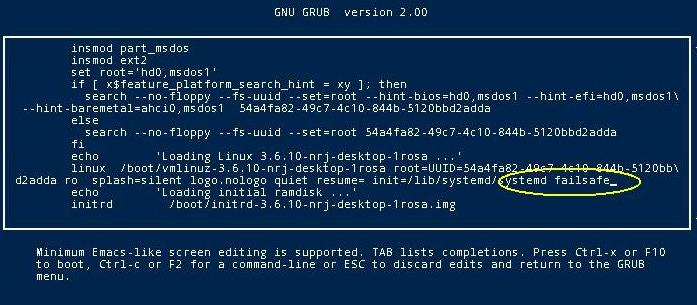Errata ROSA Desktop R1
Known release problems
Contents
- 1 Hardware issues
- 1.1 Warning with AMD Radeon HD 2xxx-4xxx series card
- 1.2 Incorrect screen resolution after boot
- 1.3 When using proprietary NVIDIA or AMD/ATI drivers, artifacts can appear on the screen during the boot
- 1.4 I have hybrid ATI/Intel graphics and I cannot boot using ATI card
- 1.5 Backlight/Brightness workaround for laptop Packard Bell TE11HC-B8302G50Mnks
- 1.6 Start in recovery mode
- 2 Software issues
Hardware issues
Warning with AMD Radeon HD 2xxx-4xxx series card
AMD does not provide update compatible with the latest version of Xorg 1.13 embedded in ROSA 2012 Desktop. Don't try to install Catalyst 12.6 driver unless you know exactly what you are doing.
Incorrect screen resolution after boot
If you monitor supports high resolution but a lower one is chosen during the boot, use the following workaround:
1. Install lxrandr
2. Launch it from a command line AS A USER and set necessary resolution from the list appeared
3. Press SAVE to create a config file that will be automatically used in future
When using proprietary NVIDIA or AMD/ATI drivers, artifacts can appear on the screen during the boot
If you see artifacts on your display, press Ctrl+Alt+Backspace to restart X-Server
I have hybrid ATI/Intel graphics and I cannot boot using ATI card
Unfortunately, the full-featured support of this combination is announced but not implemented correctly (yet) in X-Server 13. Use Intel graphics card by disabling AMD/ATI one in BIOS or add "xserver=intel" by editing edit the following line in the /etc/default/grub file (with root privileges):
GRUB_CMDLINE_LINUX_DEFAULT='splash=silent logo.nologo'
We'll get you know when support for this cards combination will be fixed.
Backlight/Brightness workaround for laptop Packard Bell TE11HC-B8302G50Mnks
The FN-F11 and FN-F12 combinations doesn't work to adjust brightness/backlight of screen. When you push this combinations nothing happens.
Solution: To have a functional brightness adjustment you need to put acpi_osi=Linux acpi_backlight=vendor on the grub line with mcc. After a reboot all is ok, you can set brightness up or down with button combo.
Start in recovery mode
Start in recovery mode. Mode "recovery" isn't present by default in ROSA Grub. If you find yourself stuck for one reason or another you can still force a recovery boot by following this procedure:
1. Boot to the standard Grub2 menu and stay with the first entry
2. Type "E" for edit
3. Locate the line "init =/lib/systemd/systemd" and move the cursor at the end
4. Insert a space then type => "failsafe" as shown the example
5. Then, without doing anything else, press the F10 key.
You are in console as root to make corrections
Add "recovery mode" in grub
It is possible to always have "recovery mode" entries in the grub bootloader
1. Go to the KDE Control Center (systemsettings)
2. Go to "System Administration" section, select "Startup and Shutdown" and check the option to generate recovery entries.
Software issues
Applications that use OSS don't work (no /dev/dsp or /dev/audio)
Since old OSS modules are not supported anymore, you should use ossp - free implementation of OSS wrapper in Pulseaudio. Install it using this command:
urpmi ossp
or using the package manager and reboot. Check if the cuse module is loaded:
lsmod | grep cuse
If everything is ok, applications can use OSS as usual..
Cracking sound in Skype
On some hardware configurations, one can get a crackling sound in Skype. To solve this issue, open /etc/pulse/default.pa file with root privileges and find the following line:
load-module module-udev-detect
replace it with:
load-module module-udev-detect tsched=0
Save changes and reboot. For more information, see #288
